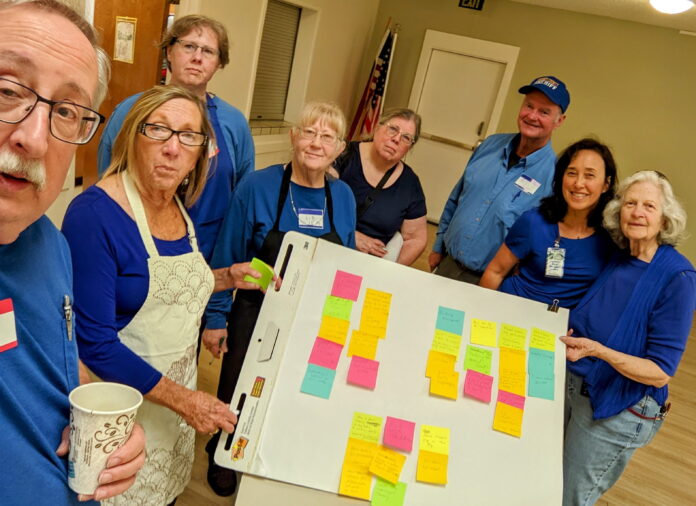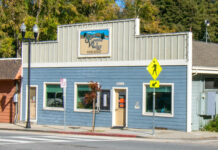
First responders are key to keeping San Lorenzo Valley residents safe in the face of potential emergency situations, but there are other civilian groups that are stepping up to help fill in the gaps.
Enter the San Lorenzo Valley Emergency Network (SLVEN). On Oct. 2, members of SLVEN joined with SLV ARES (Amateur Radio Emergency Services) and other local agencies to brainstorm ideas for managing actions and communication during any emergent event, including fires, floods, earthquakes and land or mudslides. The acronym ARES refers to those who use ham radios to manage communication, and applies to residents who share information outside of official first responder channels.
About two dozen people attended the event at Highlands Park Senior Center, including Tami Tracey, Board President of SLVEN. While some community members may be familiar with Community Emergency Response Teams (CERT), the latter organization was started by SLVEN, allowing for shared resources, including volunteers. SLVEN was started over a decade ago, and works to provide education and assets around disaster preparedness to community members and agencies.
Tracey explained that the gathering of various representatives at the weekend event was to allow for the interchange of ideas, questions and concerns.
“We’ve been through wildfires and floods and earthquakes; what can we do jointly to address the needs of our constituents to be more effective in all phases of a disaster?” Tracey asked.
On-hand to gain information and share insight was San Lorenzo Valley Unified School District (SLVUSD) Superintendent Chris Schiermeyer.
“The school district sites are an integral part of the valley, so anything that impacts those sites affects our students and families. Being part of this network helps us better understand what resources we can tap into, and what assistance we can provide in an emergency,” Schiermeyer said.
All of the schools in the district are designated as Red Cross sites, so in the event of an emergency, individual schools may be called upon to act as evacuation sites. Schiermeyer is quick to acknowledge that it’s a symbiotic relationship when it comes to emergency management.
“CERT members have helped us with parking and helping new parents understand traffic flows around the tri-campus area, and we all appreciate the collaborative approach we gain by working with each other,” Schiermeyer said.
While each SLV school site is required to have its own emergency plan and incident commander, Schiermeyer points out that the district has an umbrella plan for all sites, including communications, operations and finance.
“We all have our roles to play in the event of an emergency. I’m a community member, and anytime there is something happening in our neighborhoods, I’m actively ensuring that the needs of our students and their families are being met,” Schiermeyer said.
Andrew Lucia, in his third year as Assistant Superintendent for Human Resources with SLVUSD, was at the event to connect with other safety organizers and agencies.
“We have a lot of people that are on our school campuses each day—2,300 kids and 300 staff—so we need to ensure that everyone is safe,” Lucia said.
Lucia comes from Santa Clara Unified School District, and by his own admission, has a lot of experience with emergency management. As an SLV resident, he has a vested interest in the health of the community.
“There are a number of organizations that are ready to help, from horses to houses—a lot of people are ready to provide assistance to those who need it,” Lucia said.
Want more information on joining any of the groups mentioned above?
Speaking of horse helpers, Mary Sullivan-White, Director of the Santa Cruz County Equine Evacuation, leads a coalition of more than 120 volunteers across the county who assist with animal evacuations in the event of an emergency. The group was started in 1983 after the El Niño storm hit the region, resulting in historic rainfall and subsequent flooding. Sullivan-White joined the agency in 2006, and has been present for the removal of animals during the multitude of fires and floods that have impacted the area.
“It takes a lot of effort to organize these rescues and mobilize our volunteers,” said Sullivan-White. “It’s really a labor of love.”
She’s quick to point out that the organization prefers to work with animal owners on emergency preparedness rather than emergency response.
“We really want people to be prepared for any event. Animal owners need to have their own evacuation plan established; we shouldn’t be their Plan A,” said Sullivan-White.
Want more information on joining any of the groups mentioned above? For information on SLVEN, visit sites.google.com/view/slven/home. For information on ARES, visit xczcomm.com. For information on Santa Cruz Equine Evac, equineevac.com.












